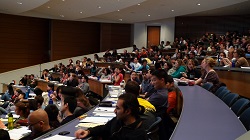A year after writing an article for our magazine, Sue Dixon of P4C and Thinking Child returns with a piece on how best to teach the art of listening to pupils. After all, a lot of fun can be had...

When I was little and chattered too much, my mum used to say “Susan Ellen! (She always used my ‘Sunday name’ when I was in trouble) You know it’s no accident that you have two ears and only one mouth. Do shush and listen for a moment.”
And then, by no surprise, I became a teacher: traditionally a role perceived as more about talking than listening. Listening isn’t something that is overtly taught in teacher training college, but I believe it should be.
Which of the following is more likely to improve the quality of teaching and learning in your school:
a) Observing a whole lesson or part of a lesson, feeding back with a judgement on the quality of teaching and learning. ‘Outstanding’, ‘good’ or ‘requires improvement’.
b) Observing a lesson or part of a lesson as part of a professional development cycle with built in feedback (and no-grades).
Rosemary Dewan of the Human Values Foundation returns to discuss the 5-star education system, and how it can help both teachers and students get the most out of the teaching process.

Learning is engaging when children and young people are stimulated and excited by it and see the relevance of it. They are constantly making decisions and it’s helpful for them to begin to understand and become aware of the drivers for their choices. Take for a moment, what it was that made you decide to get out of bed this morning! You will probably soon find that there were some key factors – things that you personally value and consider important. So, how can we help young citizens enjoy making connections while they are learning so that they can develop a consistent approach to their thinking, decision-making, choices and behaviour – and ultimately feel happy and achieve their full potential?
Every year I make the attempt to alter my voice to become characters in stories that I read to the class. Every year I try to set the tone for our reading with pictures, lights, and sounds. Every year I some how fall short. I either forget the dialect I originally used, I play the wrong kind of music in the background, or I’m honestly just having an off day.
How best to capture a student’s interest? Mo Yafai, Shireland Collegiate Academy’s Curriculum Theme Manager, considers themes to be a great way of encouraging curiosity and enjoyment in the classroom.

Themes are contextually diverse vehicles for learning. They provide meaningful contexts in which students have the opportunity to achieve proficiency in a range of competencies. Each theme gives students the opportunities to acquire the skills needed to be successful at Key Stage 4 and promotes social responsibility as well as personal reflection and growth.
To ask what makes an excellent theme, is to ask what are the conditions for excellent learning. The core learning and teaching principles that underpin an excellent theme are as follows:
How do you best entrance students in your lessons? The technology for bringing stereoscopic images into lessons is available to teachers, but is it all part of a fad?
As published in the September 2013 edition of our magazine.

When a lesson is presented in stereoscopic 3D, the lesson material appears to physically float or hover in the classroom. This is accomplished by sending differing, carefully defined images to the students’ left and right eyes, and with proper hardware and software these images create very convincing illusions of depth and volume.
Imagine showing a beating heart, or the nucleus and orbiting electrons of an atom, or the dynamic birth of a galaxy, to your students in this manner. The visually engaging, almost visceral 3D experience helps bring the lesson material alive, making it more ‘real’ and memorable.
But there are some people who feel that using 3D in the classroom is simply a gimmick – today’s proverbial ‘shiny object’, just a passing fad. A grand delusion, if you will.
Given how hard teaching is from time to time, it’s important to concentrate on the many positives. Downe House’s head of MFL discusses how to battle apathy and annoyance.

I do like my job. Of course, I do have moments when I want to pack it all in or plan myself a new career but those are normally moments at the end of term when I know that I am at my lowest point in terms of energy and creativity. It’s often at that time that I feel overwhelmed with my to-do list which I write out religiously everyday. There are even days when I have been too busy the night before to write out my plans so I will write it out after the events have happened so that I can cross out each achievement with satisfaction. Tell me I am not the only one who does this?
So, with all this negative press about teaching how could I possibly like my job? It is not easy to identify one particular thing. I enjoy many aspects of the job I do. I think most importantly I enjoy teaching and I enjoy thinking about how best to convey what I want my pupils to learn. I love thinking of ways to engage my classes so that they are motivated and inspired to learn. It’s what I feel is the creative element of my job and I know that I do have some good ideas. However, importantly, I also know that it is important not to reinvent the wheel. Inevitably, someone in my department or one of the lovely #mfltwitterati will have a great idea to share and so I never feel that the ideas have run out. I consider myself incredibly lucky in this respect. Creating is what I do when I have got all the horrid stuff out the way. Yes – there are elements of the job that I do not like. Marking. I don’t like marking. Well, I like it because I can see what my pupils have mastered and how well they have done. On the other hand, there is nothing more depressing than sitting down to a pile of marking or papers full of mistakes on the very grammatical concept you have just spent a week or so teaching. So, marking is something I do not enjoy. In fact, right now, I’m putting off marking…
On 30th January, we featured an article by Adam Lewis on how he aims to teach like a champion. In this follow up piece, he discusses how he has altered his teaching methods further in order to fit in with this ideal.

I have continued to employ the methods put forward in my last blog post. These adjustments are now starting to become embedded into my practice, so that I am actively aware that I am using them consistently and this seems to be having a positive effect on my students. I will now not continue until every hand is straight up and, as a result, all my classes are quicker to be ready to listen with their hands straight up in the air a lot quicker than previously in the year.
Similarly, if one student is not following the procedure, I use positive group correction ("thank you to the whole of the left side of their room with their hands straight up") and, if not successful, move on to anonymous individual correction ("I'm just waiting on one student on the right side to put their pen down and put their hand straight up"). This has resulted in some students admonishing the student who the class is waiting on, which is negating the positive effect of the anonymous individual correction, but on the other hand, it does seem to be creating a strong team within the class.
I have adjusted my technique to include tracking the speaker. These are clear instructions to turn and watch the person who is speaking at the time. Although this is not completely embedded, I am reminding the students who are often the ones not seen tracking to try and do this consistently. When I introduce SLANT into my practice, I hope that this will be even more consistent.
Schoolchildren possess growing, developing minds, ones which can often wander. Therefore, it’s important for teachers to know how to retain their attention. To discuss this further, Innovate my School regular Adam Lewis discusses how to ‘teach like a champion’.

For the following weeks, I am focussing on creating a strong classroom culture by adhering to the techniques advocated by Doug Lemov in his 'Teach Like a Champion' manual for teachers.When I posted on Twitter that I was starting this experiment, Doug kindly tweeted me asking for me to let him know which techniques I was going to focus on first.
Although I have been teaching my current classes for over a term, I still feel that some of them don't have the kind of classroom culture that I expect. Establishing this is vital for any relationships to exist and develop, so this is the first 'section' of the techniques that I will focus on.
Week 1 of my 'Teach Like a Champion' marginal gains experiment and I am concentrating on '100%' and 'Sweat the Details.

A community-driven platform for showcasing the latest innovations and voices in schools
Pioneer House
North Road
Ellesmere Port
CH65 1AD
United Kingdom